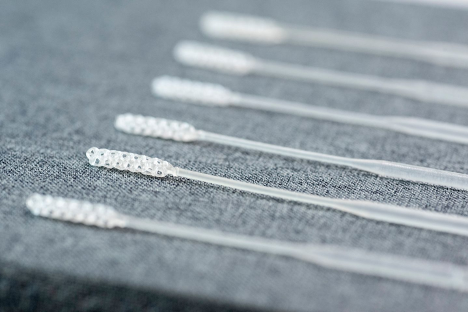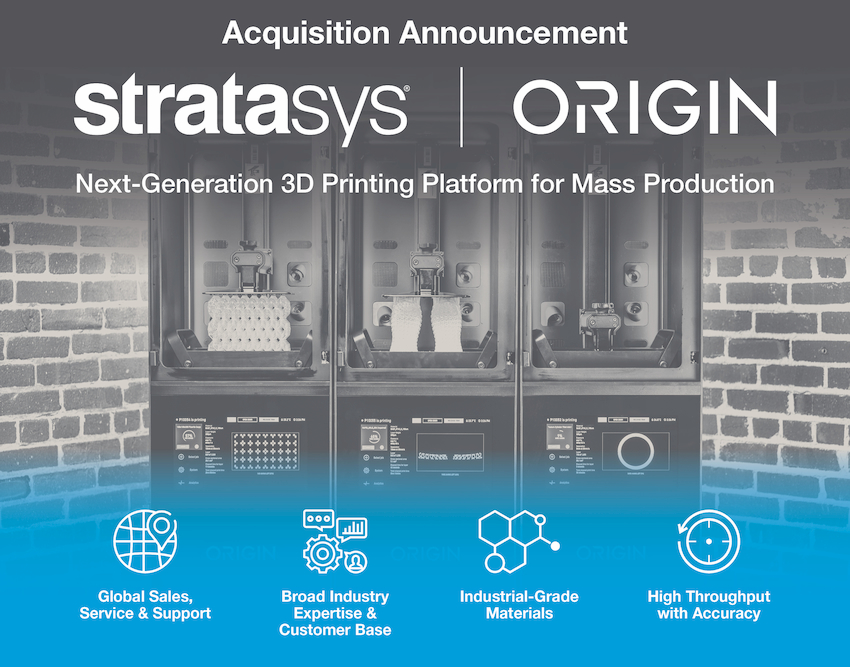Former shareholders of vat photopolymerization (VP) startup Origin are in the midst of arbitration with Stratasys for what they claim was a breach of their acquisition agreement when they were bought by the 3D printing stalwart in 2020, according to a lawsuit filed by the former shareholders on June 27, 2023. The latter lawsuit is meant to prevent Stratasys (Nasdaq: SSYS) from performing a merger, and thus “dissipating assets” before the arbitration can be settled.

Nasal swabs 3D printed by Origin during the COVID-19 pandemic. (Image courtesy Origin.)
Breach of Acquisition Agreement
Origin was a unique startup that developed what it called Programmable PhotoPolymerization (P3), a process for making robust resin parts. It was purchased by Stratasys in December 2020 as a part of the company’s foray into VP, which also included the roll up of RPS in the UK. According to the suit, the former shareholders claim “that Stratasys breached the parties’ Acquisition Agreement (defined below), misled the Former Shareholders, and deceptively enriched itself by refusing to pay them the agreed value of their company and related technology.”

The document suggests that the startup was bought for “approximately $60 million up front and another $40 million as part of a three-year earn out,” however, “Stratasys’s senior management and board members engaged in a pattern of misstatements and knowingly false representations designed to deprive the Former Shareholders of their bargained-for consideration.”
The shareholders cite Stratasys’ own public statements of the value Origin provided to the 3D printing leader to say that it provided Stratasys with “the largest year over-year growth in its recent history and substantially contributed to the increase of Stratasys’s enterprise value, with projected revenues of hundreds of millions of dollars from the Origin business unit.” In turn, they are seeking between $40 million and $400 million in relief. Now that it is in the midst of an upcoming merger, the shareholders are concerned that the company will still not pay what they believe they were owed from the acquisition.
The earn out was dependent on a three-year time period in which Origin sales would need to meet certain revenue targets before the earn out could be completed. The date when that countdown began was tentatively set for July 1, 2021, but could be changed with a “simple written agreement.” According to the lawsuit, the date was then changed based on when Origin products would be “generally available,” which was in February 2022. Nevertheless, the document suggests that Stratasys determined the original date of July 1, 2021 to be when revenues would be tracked and, as a result, would not pay the former shareholders for that first seven months, when their products were not being sold. The lawsuit reads:
“Stratasys’s conduct was calculated to deprive the Former Shareholders of the bargained-for purchase price by making it impossible for Origin to satisfy the first Earn-Out Target and for the Former Shareholders to receive the full amount they are entitled to for that period. Stratasys knew that by claiming the EO Date was not moved, it could deprive the Former Shareholders of that bargained-for amount, keeping both those funds and Origin’s intellectual property for itself.
Stratasys completed its scheme by sending a purported Earn-Out accounting statement to the Former Shareholders on August 29, 2022.
That knowingly false document claimed that the Earn-Out Target for the first Earn-Out Period had not been met, and concluded that the Former Shareholders were entitled to zero dollars for the first Earn-Out Period. It did so despite the fact that the Origin business unit has outperformed all expectations and was responsible for Stratasys’s record-breaking performance in the quarter that Stratasys finally put the Origin products on the market.”
The lawsuit argued that the Origin co-founders were stripped of their duties after the purchase, saying, “once Stratasys had extracted the valuable services from [Origin founders] Messrs, Prucha, and Ong that it needed to ensure the success of the Origin business unit, it sidelined them and began to force them out of the company altogether…” They suggest that this was meant “to deprive the Former Shareholders of the bargained-for purchase price by making it impossible for Origin to satisfy the first Earn-Out Target and for the Former Shareholders to receive the full amount they are entitled to for that period.”
Undisclosed Arbitration
Interestingly, there is a section in the document claiming that, in the midst of filing merger-related paperwork, Stratasys didn’t want the arbitration to become public. The arbitration began May 19, 2023, with read receipts confirming that the company’s council received them, but, as of the new lawsuit’s initiation, Stratasys had not yet filed anything with the SEC about it. It had, however, disclosed certain lawsuits that it is engaged in:
“As part of those [merger-related] events, Stratasys’s public financial and related disclosures signal that it intends to ignore or omit the Former Shareholders’ claims as part of any transaction. In fact, in its most recent June 20, 2023 financial disclosure Form F-4, which pertains to Stratasys’s anticipated merger with Desktop Metal, Stratasys disclosed certain lawsuits at length over the course of several paragraphs. But it makes no mention at all of the Former Shareholders’ claims.”
This, the former shareholders argue, “strongly indicat[es] that Stratasys does not intend to engage with the Former Shareholders’ claims in a fair and good-faith manner.” Out of fear that the merger activity will be used “as cover for improper transfers” and result in the company not concluding the arbitration, the former shareholders are seeking an injunction on any merger unless Stratasys adds a stipulation related to compensating them.
Stratasys Merger Gets Complicated
From the sound of it, though, Stratasys still has time to make its payments to the former shareholders, as the document notes, “In subsequent discussions regarding the dispute, Stratasys indicated that it would not make any payments at all until the end of the third Earn-Out Period.” While it may attempt to discount the first seven months after the acquisition, it may still pay the shareholders by the end of the third earn-out period, which would be July 1, 2024.
What the lawsuit suggests is that the former shareholders have no desire to be an obstacle to the merger, but want to ensure that the assets and liabilities related to the former Origin shareholders not get separated so that there is an opportunity to settle arbitration fairly. So, even if Stratasys intends to pay them by July 1, 2024, nothing happens in the interim that would change that, such as a merger that sees the company’s liabilities somehow spun off into a separate business entity.
Nevertheless, it is the latest in a series of complications being faced by Stratasys as it attempts to move forward with Desktop Metal (NYSE: DM) merger. The saga seemingly began when Nano Dimension, an Israeli manufacturer of electronics 3D printers, began an attempt at a hostile takeover of Stratasys while it faces its own hostile takeover by its institutional investors. At the moment, Nano Dimension is attempting to bypass the Stratasys Board by making a tender offer to shareholders at large that would give it majority control of the company. Meanwhile, 3D Systems has made two bids to purchase Stratasys, which activist investor Donerail argues the Stratasys Board is not adequately considering. Desktop Metal, too, is involved in a lawsuit from its own institutional investor over a poison pill it adopted.
The drama is messy to say the least. It seems that, while Stratasys and Desktop Metal are resolute in merging, there are numerous forces that don’t want that to happen. It could very well be that some parties simply want Stratasys to do what’s best for its shareholders or that a Stratasys-Desktop combination could be too big of a threat to other interests. Regardless of who benefits the most from slowing down the merger, it’s clear that the path forward is going to be anything but simple.
Subscribe to Our Email Newsletter
Stay up-to-date on all the latest news from the 3D printing industry and receive information and offers from third party vendors.
You May Also Like
Precision at the Microscale: UK Researchers Advance Medical Devices with BMF’s 3D Printing Tech
University of Nottingham researchers are using Boston Micro Fabrication‘s (BMF) 3D printing technology to develop medical devices that improve compatibility with human tissue. Funded by a UK grant, this project...
GaeaStar and Verve Coffee Roasters Start Pilot Production of Sustainable 3D Printed Coffee Cups
Following a 2022 debut in Germany, GaeaStar, a startup based in San Francisco and Berlin, has begun US pilot production of its sustainable, disposable clay cups and bowls made with...
Meltio and Accufacture Unveil Robotic Metal 3D Printer Made in the US
Meltio has partnered with Michigan-based robotics firm Accufacture to introduce Alchemist 1, a robotic cell designed for wire-laser metal 3D printing made in the US. This new system represents a...
WASP Highlights Advances in Healthcare 3D Printing at Italy’s Exposanità 2024
WASP takes center stage at Italy’s leading healthcare expo, Exposanità 2024, demonstrating the transformative impact of its advanced 3D printing technologies on the medical sector. Known for its line of...
































